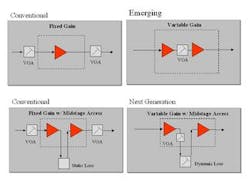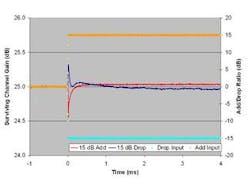Erbium-doped fiber amplifiers for next-generation networks
New designs require more than optimizing optical performance parameters.
Dr. Kai Wundke
Corning Inc.
In today's modern photonic networks, optical amplifiers are used as line amplifiers between fiber spans, as pre- and booster amplifiers, as loss compensators in optical add/drop multiplexer (OADM) nodes, and as power equalizers, to name only a few possible applications. Each application drives a different set of design requirements in terms of performance.
Much development effort in the past has been geared towards meeting specific performance targets while minimizing impact on cost and size. Recent changes in the marketplace have greatly shifted that focus. Next-generation design requires more than optimizing optical performance parameters (such as the noise figure) for any particular gain setting. Cost, scalability, size, embedded firmware functionality, as well as power supply and dissipation requirements -- once considered "secondary" parameters -- have emerged as important design elements.
Changing focus
Recent demand for reconfigurable long-haul network architectures, which reduce cost and improve system performance, began the shift in design focus for optical amplifiers. Today, the growing demand for deployment of higher-bandwidth services closer to the end customer has shifted the focus even further as system operators require a new class of amplifiers for regional, metro-core, and metro-access networks.
The requirements for optical amplifiers in these emerging network architectures are very different. These networks demand tolerance of a much wider dynamic range of channel load and launch powers, rapid and accurate network reconfiguration without traffic interruption, new protection schemes, and new and more complex loss elements such as dynamic dispersion compensation modules and OADMs. Moreover, service providers only benefit from these new features if they are accompanied by much higher package density and lower overall installation and operating costs.
Reconfiguration and pay-as-you-grow network upgrading could cause an amplifier that today sees only a single channel to be used for as many as 100 or more channels in the future. This wide range of channel count together with variation in fiber span lengths and the use of high, dynamic loss components yields input power ranges of up to 40 dB as well as gain variability of at least 15 dB.
Additionally, ultra-fast and accurate transient control becomes increasingly important as networks migrate to reconfigurability. These controls prevent large surviving-channel gain excursions during channel add and drop events. A potential decrease in the surviving-channel gain during such a transient event would cause performance degradation due to eye-closure and optical signal-to-noise ratio (OSNR) degradation at the receiver side. Also, an increase in the surviving-channel gain can build up throughout the network and potentially damage other line components and receivers.
Another important requirement is the need for truly configurable midstage loss compensation to enable the use of a wider variety of loss components such as a static dispersion compensation module with a fixed time delay or a dynamic OADM with a time-dependent loss profile.
Package size and density
In most applications, but specifically in the metro-office environment, size and package density become important issues. To optimize rack configuration and space utilization, optical amplifiers, including the thermal dissipation scheme, have to be able to fit on the same card pitch (25 mm or less) as any other rack-component. Package density must be increased by adding more functionality onto the same card and into the amplifier itself. For example, supervisory channel add and drop, optical performance monitoring, and transceivers now must be included in a footprint that was formerly reserved for optical amplifiers alone.
To accomplish such high package density, small-form-factor optical components such as pump lasers, variable optical attenuators (VOAs), and photodiodes are important. Equally important are optimization of printed circuit board (PCB) space utilization and the ability to minimize component holding schemes. Intelligent fiber routing or new specialty fibers to avoid parasitic bend losses must be considered, as well as management of total fiber length to accomplish the required overall package density.
Higher package density and added functionality means next-generation EDFAs will not have the disadvantage of conventional EDFAs -- that the gain medium alone limits the overall package size. EDFAs will be able to provide a wide set of functions in a package size formerly reserved for other technologies such as erbium-doped waveguide and semiconductor amplifiers.
However, designers must ensure that size-related requirements and added functionality do not sacrifice the module's overall reliability. This requires careful consideration of new optical subcomponents as well as electronic controls and PCB layout.
Power efficiency
Wall-plug power efficiency and power dissipation are important elements in any next-generation amplifier because both parameters directly affect total system operation cost. The challenge is to consider power efficiency in the context of long-term reliability.
In the past, the main driver for power efficiency was the pump laser itself. As a result, much attention has been paid to the possible use of pump lasers without thermo-electric coolers (TECs). The power and cost improvements achieved with these pumps, however, are tempered by severe limitations on important performance parameters such as output power and performance stability over temperature. The tradeoff has limited the use of these pump lasers to low-end applications.
Today, however, designers can take advantage of improved pump laser and TEC designs and manage power requirements more intelligently. For example, the peak power consumption over temperature of an amplifier that includes erbium-doped fiber heating (a feature needed to control temperature-induced gain variations) can be the same as an amplifier without that feature. This is done by matching the maximum and minimum power requirement of the pump and heater and vice versa. In this case, no peak power penalty is paid and the amplifier with the fiber-heating scheme is far superior in performance. Design parameters for power efficiency also should include aspects of the package design, choice of specialty materials, design of drive electronics for pump laser and TEC, and embedded controls.
Integration of multiple functionality
Conventional EDFAs have limited dynamic operating ranges and transient capability. Therefore, system engineers have had to place VOAs in front and after the amplifier, as shown on the left-hand side in Figure1, to buffer the increased variability. This use of VOAs causes severe OSNR and optical power penalties as well as significantly lower wall-plug efficiencies, increased size, and added cost. System vendors also had to merge the VOA and the amplifier controls together on a higher level, which further increased complexity and cost and reduced overall performance.
Emerging controlled amplifier designs, as shown in Figure 1, partially circumvent that problem by providing a much wider dynamic gain and power range. The designs also provide lower OSNR degradation compared to conventional fixed-gain amplifiers. Still, these designs require placing two amplifiers back-to-back to compensate for high-loss components. The performance optimization that balances the two amplifiers and the midstage loss must be implemented at a higher system level, which intrinsically limits the overall performance because the optical and electronic designs can not be woven together as intimately. With the integration of multiple gain stages and truly dynamic midstage loss compensation, the design of the embedded transient suppression control becomes more complex. It needs to guarantee the same surviving channel gain excursions at the midstage access port as well as the output of the amplifier.
Creating a roadmap
Figure 2 shows a typical surviving-channel transient suppression of a next-generation high-performance EDFA. Here, the total gain excursion for a 15-dB, µsec add and drop is less than 0.5 dB, which also includes the steady-state gain offset, and the surviving-channel gain settles within +/- 0.1 dB of its target value in less than 100 µsec. This amplifier is designed to maintain performance over an input power dynamic range of at least 36 dB and a dynamic gain range of at least 15 dB. The transient performance is achieved by monitoring only the total input and output power at each gain section, i.e., without additional optical filtering.
The typical steady-state gain ripple of this amplifier, defined as the steady-state gain peak-to-peak variations between 1529 nm and 1565 nm, is only 0.5 dB, and remains constant over its entire dynamic gain range as well as over a temperatures range from 0ºC to 70ºC. The mid-stage loss compensation is dynamically configurable, and can be as much as 12 dB. It does not need additional external compensation elements, reducing the number of network components and system complexity. Furthermore, because of its flexible control architecture, the amplifier can be used as a separate pre- and booster-amplifier before and after a dynamical OADM module and still guarantee the demonstrated transient suppression capability.
The integrated all-electronic controls consist of a high-speed portion for transient suppression as well as a slower background controller, which is used to monitor internal performance parameters as well as external network parameters. For example, the input and output powers of the amplifier are monitored as well as the midstage loss and the reflection of components downstream of the amplifier itself.
In addition, the software-configurable transient control can be set to further minimize gain cross-talk between channels for modulation frequencies in the audio band. This enables the use of audio pilot tones for channel identification and performance monitoring purposes even in the presence of multiple DWDM channels. In addition to high performance, the optical, electronics, and mechanical designs enable an overall size reduction of more than 60 percent compared to its precursor without midstage access.
Finally, configurability of hardware and software features, such as number of gain stages, additional monitoring, and the communication interface, must be designed into the product from day one. This added flexibility enables cost effective tailoring of amplifier performance to the particular needs of different network architectures.
Conclusion
Design flexibility and functional integration in next-generation EDFAs will reduce overall network cost, improve overall performance and provide a new set of features. In essence, system operators will get a proven, high-performance technology (low noise, high output powers, and data rate transparency) without sacrificing cost efficiency or size. As a result, EDFAs not only become a key enabler for next-generation, agile networks, but also widen the vision of how these highly integrated optoelectronic components can advance optical communication.
Dr. Kai Wundke is a scientist with Corning Photonic Technologies Inc. (Corning, NY).

